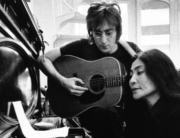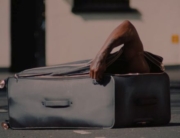
Polly Jean Harvey is one of a kind: a sharp, mercurial, passionate performer who is one of the most arresting musical figures on the rock music scene of the past 30 years. Her music is sophisticated, raw, and deeply emotional.
The documentary PJ Harvey: A Dog Called Money chronicles the making of her 2016 album, The Hope Six Demolition Project, which was based on her impressions of her visits to Kosovo, Afghanistan, and Washington, DC. The film toggles between her travels and the recording sessions. There seems to be three distinct themes in the film: music, faith, and politics, and how they are represented in underprivileged societies.
There are a few problems, though. Harvey, again, is a fantastic musician and a brilliant lyricist and a powerful presence in a live musical setting. But she is not, as we learn, as strong as a poet. Most of her observational prose poetry, heard in voice-over, comes across as fairly obvious and pedestrian.
On the other hand, Murphy has a stellar reputation as a photojournalist. His images are powerful, with a strong sense of tension. In a sequence set in Afghanistan, soldiers are casually arrayed while farmers are herding goats. The image speaks volumes to the U.S. presence in Afghanistan. In another sequence, an unnamed young Black man walks through the Washington, DC, project where he grew up, and as he gives a tour, he points to where a cousin killed himself, where his father was shot, and where he was threatened with his life. He acknowledges the violent environment and that he also misses it; he grew up there.
Yet there is very little momentum. The film leapfrogs from one town to another as Murphy tries to connect the dots between the three locations, and it doesn’t quite work. The scenes coalesce as more as a travelogue than anything else; no one person is profiled for more than a few minutes.
Things become interesting in the recording studio because music is Harvey’s element. One of the best moments occurs when her saxophonist wails away, playing a ferocious blues number while all the proper British folk have headphones on listening to the song in the mix, tapping their feet and nodding ever so politely.
Harvey is, as self-described, notoriously shy, and it shows. She shrinks in the background in her travels, possibly out of respect because she is not in her cultural element. She’s at her most effusive is in her recording sessions as she chats and directs the musicians.
There’s an odd aspect to the proceedings, however. Harvey built the studio so that it has a few one-way mirrors so the public can watch her and the band record. This element is introduced in the beginning, and we see people staring in, but this device is infrequently used. It’s noticeable because it feels like an odd disconnect: Harvey travels to and writes about many troubled places and then invites hip Londoners to watch her record. The juxtaposition is presented but not addressed.
Why did Harvey feel it necessary to chronicle this album? What is her and Murphy’s objective and message regarding the film? It’s hard to say. But if you buy the album, and I think you should, Harvey’s message is crystal clear. It’s a beautiful piece of work.






Leave A Comment